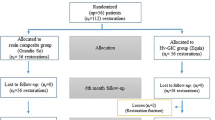Abstract
Objective
To compare the 3-year clinical performance of high-viscosity glass ionomer restorations with that of composite restorations in non-carious cervical lesions (NCCLs).
Materials and methods
One hundred thirty-four NCCLs were randomised into two groups according to a split-mouth design. In the experimental group (Hv-GIC), lesions were restored with a high-viscosity glass ionomer (EQUIA Fil, GC), whereas a composite resin (G-aenial, GC) was applied in the control group (E&Ra/comp). All restorative materials were used according to the manufacturers’ instructions. Clinical evaluations were performed after 1 week, 6 months, 1 year, 2 years, and 3 years using FDI (World Dental Federation) criteria. Data were analysed using Friedman’s ANOVA and Mann-Whitney U tests (α = 0.05).
Results
While retention rates of the Hv-GIC group were 98.5%, 96%, 91%, and 87% in respective evaluation periods, no retention loss was observed in the E&Ra/comp group at any time. There was a statistically significant difference between study groups regarding the retention criterion in both the second and third years (p = 0.008 and p = 0.003, respectively). Furthermore, there was a statistically significant difference between the groups in terms of surface lustre at the third-year recall, in favour of the E&Ra/comp group (p = 0.022).
Conclusions
The 3-year clinical performance of E&Ra/comp restorations in NCCLs was better than that of Hv-GIC restorations. The most common problems in Hv-GIC restorations were a loss of retention and reduction in surface lustre.
Clinical relevance
Although the 3-year clinical performance of Hv-GIC restorations in non-retentive lesions was acceptable, it was worse than in composites. The operator should consider the benefit/loss ratio of Hv-GIC when he/she decides to use this material in non-retentive cavities, especially those that are shallow.

Similar content being viewed by others
References
Lyttle HA, Sidhu N, Smyth B (1998) A study of the classification and treatment of noncarious cervical lesions by general practitioners. J Prosthet Dent 79:342–346. https://doi.org/10.1016/S0022-3913(98)70248-3
Shira RB (1972) Pathology of dental hard tissues. JJ Pindborg, Philadelphia
Bartlett DW, Shah P (2006) A critical review of non-carious cervical (wear) lesions and the role of abfraction, erosion and abrasion. J Dent Res 85:306–312. https://doi.org/10.1177/154405910608500405
Huysmans MC, Chew HP, Ellwood RP (2011) Clinical studies of dental erosion and erosive wear. Caries Res 45(Suppl 1):60–68. https://doi.org/10.1159/000325947
Wiener RC, Wu B, Crout R, Wiener M, Plassmann B, Kao E, McNeil D (2010) Hyposalivation and xerostomia in dentate older patients. J Am Dent Assoc 141:279–284. https://doi.org/10.14219/jada.archive.2010.0161
May S, Cieplik F, Hiller KA, Buchalla W, Federlin M, Schmalz G (2017) Flowable composites for restoration of non-carious cervical lesions: three-year results. Dent Mater 33:e136–e145. https://doi.org/10.1016/j.dental.2016.12.009
Diem VT, Tyas MJ, Ngo HC, Phuong LH, Khanh ND (2014) The effect of a nano-filled resin coating on the 3-year clinical performance of a conventional high-viscosity glass-ionomer cement. Clin Oral Investig 18:753–759. https://doi.org/10.1007/s00784-013-1026-z
Friedl K, Hiller KA, Friedl KH (2011) Clinical performance of a new glass ionomer based restoration system: a retrospective cohort study. Dent Mater 27:1031–1037. https://doi.org/10.1016/j.dental.2011.07.004
Benetti AR, Peutzfeldt A, Lussi A, Flury S (2014) Resin composites: modulus of elasticity and marginal quality. J Dent 42:1185–1192. https://doi.org/10.1016/j.jdent.2014.07.004
Molina GF, Cabral RJ, Mazzola I, Lascano LB, Frencken JE (2013) Mechanical performance of encapsulated restorative glass-ionomer cements for use with atraumatic restorative treatment (ART). J Appl Oral Sci 21:243–249. https://doi.org/10.1590/1679-775720130129
Heymann HO, Sturdevant JR, Bayne S, Wilder AD, Sluder TB, Brunson WD (1991) Examining tooth flexure effects on cervical restorations: a two-year clinical study. J Am Dent Assoc 122:41–47. https://doi.org/10.1016/S0002-8177(91)25015-1
Pinto Gdos S, Oliveira LJ, Romano AR, Schardosim LR, Bonow ML, Pacce M, Correa MB, Demarco FF, Torriani DD (2014) Longevity of posterior restorations in primary teeth: results from a paediatric dental clinic. J Dent 42:1248–1254. https://doi.org/10.1016/j.jdent.2014.08.005
Namgung C, Rho YJ, Jin BH, Lim BS, Cho BH (2013) A retrospective clinical study of cervical restorations: longevity and failure-prognostic variables. Oper Dent 38:376–385. https://doi.org/10.2341/11-416-C
Pindborg JJ (1970) Pathology of dental hard tissues. Munksgaard, Copenhagen
Gurgan S, Kutuk ZB, Ergin E, Oztas SS, Cakir FY (2015) Four-year randomized clinical trial to evaluate the clinical performance of a glass ionomer restorative system. Oper Dent 40:134–143. https://doi.org/10.2341/13-239-C
Klinke T, Daboul A, Turek A, Frankenberger R, Hickel R, Biffar R (2016) Clinical performance during 48 months of two current glass ionomer restorative systems with coatings: a randomized clinical trial in the field. Trials 17:239. https://doi.org/10.1186/s13063-016-1339-8
Osborne-Smith K, Burke F, Wilson N (1999) The aetiology of the non-carious cervical lesion. Int Dent J 49:139–143. https://doi.org/10.1002/j.1875-595X.1999.tb00898.x
Vaid DS, Shah NC, Bilgi PS (2015) One year comparative clinical evaluation of EQUIA with resin-modified glass ionomer and a nanohybrid composite in noncarious cervical lesions. J Conserv Dent 18:449–452. https://doi.org/10.4103/0972-0707.168805
Van Meerbeek B, Braem M, Lambrechts P, Vanherle G (1993) Evaluation of two dentin adhesives in cervical lesions. J Prosthet Dent 70:308–314. https://doi.org/10.1016/0022-3913(93)90213-8
Gurgan S, Kutuk ZB, Ergin E, Oztas SS, Cakir FY (2017) Clinical performance of a glass ionomer restorative system: a 6-year evaluation. Clin Oral Investig 21:2335–2343. https://doi.org/10.1016/0022-3913(93)90213-8
TürkünLS KÖ (2016) A prospective six-year clinical study evaluating reinforced glass ionomer cements with resin coating on posterior teeth: quo vadis? Oper Dent 41:587–598. https://doi.org/10.2341/15-331-C
Funding
Funding for this study was provided by the Scientific Research Projects Coordinatorship of Izmir Katip Celebi University.
Author information
Authors and Affiliations
Corresponding author
Ethics declarations
Conflict of interest
The authors declare that they have no conflict of interest.
Ethical approval
All procedures performed in studies involving human participants were in accordance with the ethical standards of the institutional and/or national research committee and with the 1964 Helsinki declaration and its later amendments or comparable ethical standards.
Informed consent
Informed consent was obtained from all individual participants included in the study.
Rights and permissions
About this article
Cite this article
Celik, E.U., Tunac, A.T. & Yilmaz, F. Three-year clinical evaluation of high-viscosity glass ionomer restorations in non-carious cervical lesions: a randomised controlled split-mouth clinical trial. Clin Oral Invest 23, 1473–1480 (2019). https://doi.org/10.1007/s00784-018-2575-y
Received:
Accepted:
Published:
Issue Date:
DOI: https://doi.org/10.1007/s00784-018-2575-y




